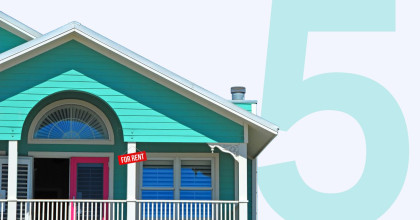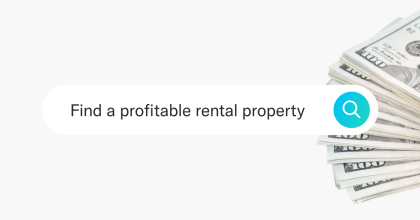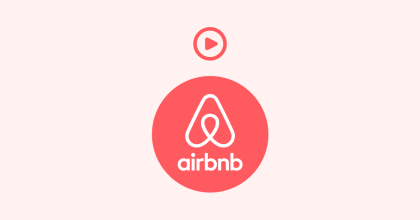Diversify Your Portfolio With Real Estate: The Why, How, & Common Mistakes
Whether you’re an experienced investor or just starting your wealth-building journey, diversifying your portfolio with real estate can be a great idea. Even during uncertain times in the stock market, people need homes to live in and, usually, offices or commercial space for shops and restaurants.
But real estate isn’t a monolith. There are so many different types of properties, and virtually endless markets and ways to invest. Here’s what you need to know about how to diversify your portfolio with real estate.
What is diversification?
In the simplest terms, diversification refers to spreading your money out in different markets, across different asset types, and with various investment strategies. You don’t want all your investing power in one stock or even in one sector of exchange-traded funds. Your overall investment portfolio can and should eventually contain investments in stocks, mutual funds or ETFs, real estate (commercial and residential), precious metals such as gold, and maybe even alternative assets like art or antiques. Basically, don’t put all your eggs in one basket.
Take the most successful entrepreneurs for example. They rarely put all of their money and time into one business, but instead, spread it over multiple businesses, joint ventures, or passive income avenues. These entrepreneurs are not at risk of financial ruin if one of their investments falls on tough times or fails completely. This is a great example of diversification for business purposes.
What are the benefits of diversification?
There are some significant benefits to diversifying your investment portfolio. When you “spread the wealth” as an investor, you spread risk between multiple types of investments. If one investment does poorly, the idea is that it will be offset by the performance of other uncorrelated investments.
Diversification also ensures your journey toward wealth won’t be so volatile. You’ll avoid the roller coaster experience that someone without a diverse portfolio feels, such as those invested entirely in individual stocks since the stock market can steeply rise or fall weekly.
Why should you diversify your portfolio with real estate investments?
It’s always important to diversify your portfolio, and to diversify each aspect of it as well. Even if you have a high risk tolerance in pursuit of short-term gains, you wouldn’t want to put all your money into the same private equity firm or mutual fund. If something were to happen to one of them, then all your money would be at risk.
Maintaining a real estate investment portfolio is widely considered to be a conservative investment strategy, as property generally appreciates in value over time, even when the stock market falters.
There are so many ways to break in — from flipping houses or holding multifamily properties for rental income, to commercial real estate investing, REITs, or real estate investment trusts, you can find ways to break in at virtually any price point. Here are some of the biggest reasons you should consider diversifying your portfolio with real estate.
Lower your overall investment risk
One of the best parts about real estate investment as a personal investment is that prices are independent of the activity on Wall Street. That is why using real estate to diversify your portfolio can lower your overall risk. While the stock market might decline in a month, the real estate market might continue to see increasing prices. This helps reduce the risk in an investor’s portfolio.
Balance out volatile investments
Another reason to use real estate to diversify your portfolio is that home prices aren’t as volatile as the stock market. When you search for real estate investments, you are going to come across median prices, or prices that are common in certain areas or neighborhoods. While some neighborhoods or rental properties may exhibit more risk, their prices will not change drastically next weekend or even next month.
Hedge against inflation
The real estate market is an excellent hedge against inflation. Property values often tend to stay on an upward curve over time because the population is ever-increasing and people always need a place to live. If you’re hesitant because you remember The Great Recession of 2008, you should know that residential home values were back above their ‘07 value in less than 10 years – reganing value much faster and with more stable growth than the stock market.
Generate income with minimal effort
Real estate investing provides you the opportunity for recurring income without any additional time or effort on your part, depending on how you invest.
Owning residential rental properties or prime vacation rentals, for example, provides you with regular cash flow you can rely on. And many property management companies will take on all the day-to-day tasks — such as cleaning, maintenance, finding renters, etc.— so the investment requires relatively little time on your part.
Additionally, property generally appreciates over time, increasing in value as costs rise, keeping pace with or exceeding inflation. Home prices have grown an average of 17.5% in the U.S. over the last yearalone.
How to diversify your portfolio with real estate
The way you balance your asset allocation depends on your time horizon and your risk tolerance. If you’re close to retirement, your time horizon is on the shorter side and your tolerance for risk should be relatively low, so you’d likely have a higher allocation in fixed income assets and securities and real estate, which aren’t as volatile as the stock market. If you’re fresh out of college and just getting started building your portfolio, you have a longer time horizon and the ability to take on more risk, so you’ll likely have a higher allocation towards stocks and real estate with little exposure to bonds. Here’s what you need to know about diversifying your portfolio.
Diversify by asset type
A balanced portfolio contains a range of different types of assets, such as cash-like assets (hard currencies or savings in money market-style accounts), property, stocks, and other kinds of investments. It’s also best to diversify within each of these categories.
For example, you may not want to put all of your investment money for the real estate portion of your portfolio into a single real estate investment group or a single type of real estate, such as commercial properties. Instead, you can protect yourself against fluctuations across the market by spreading out your investment between commercial property, residential rental properties, land, and so on..
Diversify by asset class
An asset class is a group of investments that are similar and subject to the same laws, such as commercial properties, single-family homes, and multi-family rental properties.
Diversifying your portfolio by asset class means building a portfolio with different types of assets that are unaffected by one another, so that if one asset class starts to decline, the others will remain afloat.
For example, it may be wise to invest in both vacation rentals and multi-family homes. That way, if people stop traveling—as they did during the early days of the pandemic—not all of your investments will stop generating passive income at once. Even when people aren’t traveling on vacation, rental homes are still needed for full-time residents.
Likewise, real estate is just part of this equation. It’s smart to have investments across a range of asset classes such as stocks, bonds, real estate, and cash-like money market savings accounts, which can cushion your portfolio against a crash in any one of these areas.
Diversify further across real estate markets
If the aim is a diversified overall portfolio, individual investors should buy shares in multiple properties, and in multiple markets. This is like double-diversification – you diversify into real estate and also diversify across multiple properties across the US. By doing so, you reduce your risk profile significantly, especially if there’s an issue with any singular property or area.
Within the investment world, diversification across asset classes, geographical markets, and asset types allows you to protect against the downside without significantly impacting your upside potential.
You can invest in fractional shares of real estate properties in many cities across the United States to your portfolio by investing through a crowdfunding platform like Vantage horizon. Vantage lets you buy multiple shares of different rental properties without getting involved in the hassle of owning or managing a property yourself.
Diversify by strategy
There are many strategies you can use in real estate investing to generate income while hedging your bets against market changes. Some are short-term strategies—like buying a house in an up-and-coming market, holding for a price increase, and selling as soon as the market takes off—and others rely on long-term appreciation.
For example, in some housing markets that are expected to experience significant growth in the next decade—such as in neighborhoods with long-term prospects for public transit that connects them more directly with major cities—you may plan to buy and hold properties to make rental income in the short-term and profit off of significant appreciation in the long-term. Another strategy could be to flip houses—buying them in order to renovate them and resell them quickly for a profit in a hot market.
Mistakes to avoid when diversifying your portfolio with real estate
Even though real estate is a fairly conservative investment in terms of risk, new investors often lose money when they move too quickly or don’t do enough research before closing a deal. Here are a few common mistakes to avoid.
Don’t forget to check your bias
It’s always important to remember that having a diversified portfolio is the best way to protect your net worth against market volatility. Even if your family or friends are experienced real estate investors who’ve made all their money from one type of real estate—say, single-family homes providing steady rental income—you’ll still be better off diversifying your own portfolio.
Make sure your portfolio is actually diverse
There are many different types of properties you can own, from commercial real estate like office buildings to vacation rentals and hotels to alternative investments like houseboat moorings or land you can lease out. A truly diverse portfolio would include different types of properties in different markets. If you have real estate spread across several cities and states, a downturn in one neighborhood or city where you’re invested wouldn’t tank your whole portfolio. But if all your real estate is in one place and suddenly people are moving out in droves—the way people left New York en masse during the pandemic—your portfolio could be in trouble.
Don’t invest more than you can afford to lose
While investing in a real estate portfolio is generally a fairly safe hedge against market volatility, it’s impossible to predict the future. And even if your assets remain strong during a downturn, property is still an illiquid asset, which means turning that commercial property or multifamily home into cash could take some time. Never invest so much money that you’d be at risk if you couldn’t immediately sell the assets.
Always have an exit strategy
While some real estate investments work more like stock, where you can buy and sell shares without a physical stake in a property, many others don’t. That means it’s important to know how you’re going to get out—what your sale options are or where you could look for additional investors—before you end up in an emergency situation with too much liquidity tied up.
Don’t overestimate your abilities—hire a professional when you need to
Do lots of people make significant money from flipping houses or managing residential properties on their own? Sure. But if you’re just starting out and you’ve never been a property manager, it’s easy to overlook all the work it requires to turn an investment opportunity into serious cash flow.
Always do enough research—and hire a lawyer or inspector when needed
Again, one of the biggest mistakes you can make is to overestimate your own knowledge and skills. This applies to decision-making, too. If you’re not sure you’re making a good investment, you can contact a lawyer, inspector, or other expert to go over that contract, triple-check that potentially faulty wiring, or explain how a new town ordinance or public transit route could impact a property’s value over time.
How to diversify with Vantage Homes
There are two ways to diversify with Vantage horizon. Both are extremely easy and beneficial to new and experienced investors.
Diversify with real estate
The first way you can diversify with Vantage Horizon is to invest in real estate if you do not already have any real estate present in your portfolio. We have a very simple process that includes a team of experts to make the investment process go smoothly. You can invest anywhere from $5,000 to $1,000,000 in any home or homes listed on our site.
Diversify across location
Another way you can diversify with Vantage horizon is to invest across multiple properties and markets. Consider the difference in how a home in Detroit, MI may perform in comparison to a home in San Francisco, CA. Each housing market has its own cycles.
Rather than attempting to predict each market’s cycle, you have the ease and opportunity to diversify across many markets. We have many properties available located in various cities, rural and urban, across the country. This allows you to easily find multiple, beautiful homes and spread your investment capital across the US instead of in just one or two rental properties.
Though this type of diversification has historically been limited to wealthy investors able to afford multiple properties, with Vantage horizon, you can easily invest in multiple locations because of our fractional investing model.









